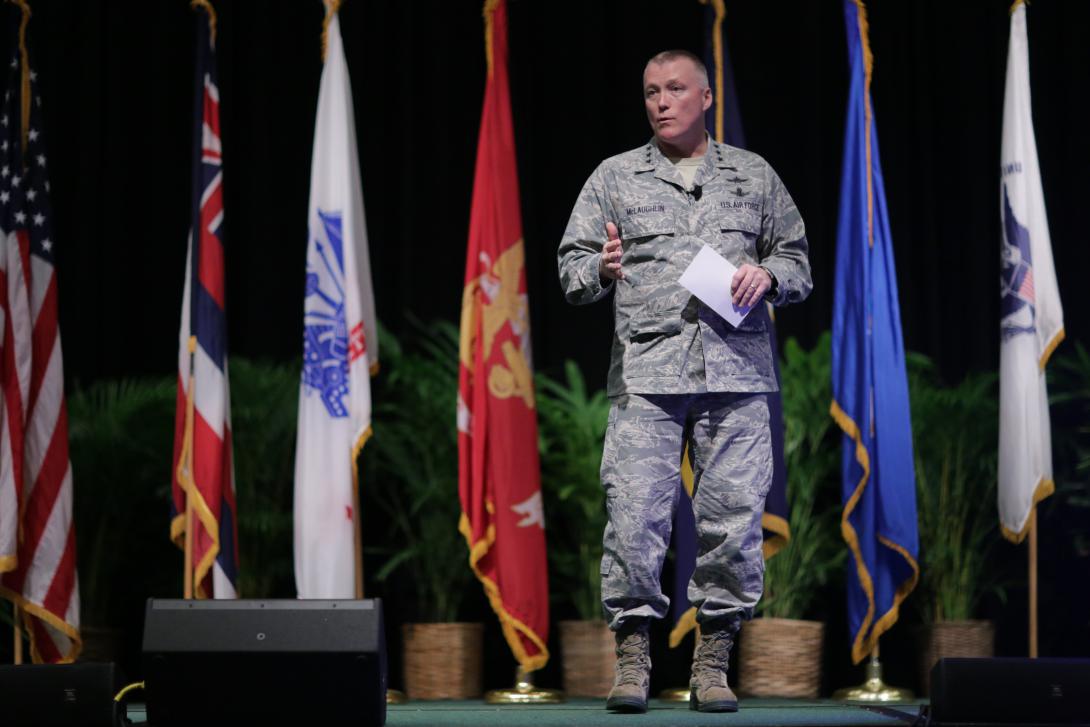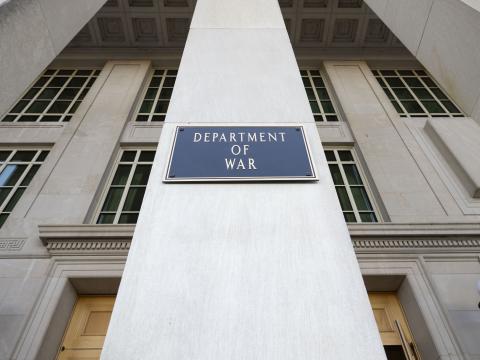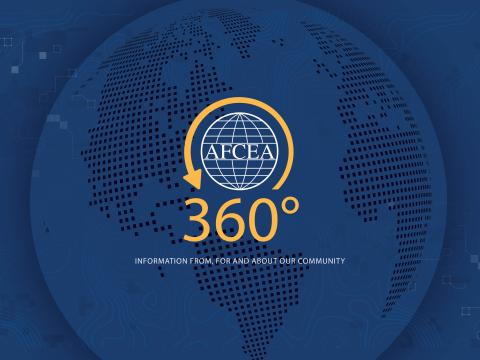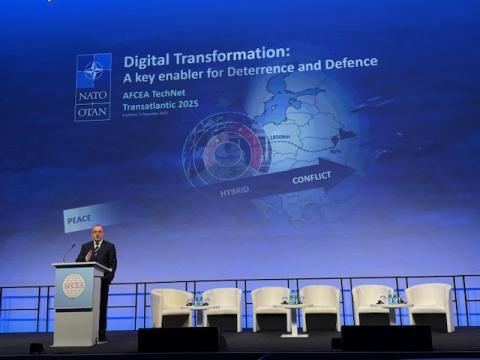Technology Defines Asia-Pacific Challenges, Offers Solutions
TechNet Asia-Pacific 2014
The SIGNAL Magazine Online Show Daily
Day 2
Quote of the Day:
“It is as if I’m building an F-22 squadron with a bunch of new lieutenants who’ve just shown up and have been checked out in the F-22. You don’t have combat capability just because you have people who have passed their initial training.”—Lt. Gen. James McLaughlin, USAF, deputy commander, U.S. Cyber Command
The U.S. Pacific Command (PACOM) increasingly is turning to technology to solve problems ranging from new threats to the tyranny of distance over the vast Asia-Pacific region. Cyberspace is both a source of challenges and a potential venue for addressing many of the challenges PACOM faces as the pace of change picks up in the globe’s largest, most populous area of operations.
Day two of TechNet Asia-Pacific 2014, being held December 9-11 in Honolulu, provided a breakdown of many of these issues with an agenda featuring a breakfast speaker and panel discussions. Cyber dominated many of the discussions, but other topics received detailed examination by government, military and industry experts.
Cyber knows no physical boundaries, so its effect on PACOM need not come from the Asia-Pacific region. Lt. Gen. James "Kevin" McLaughlin, USAF, deputy commander, U.S. Cyber Command (CYBERCOM), described how network security oversight will be changed as a result of a new Department of Defense Information Network (DODIN) concept and Joint Force headquarters DODIN operations within CYBERCOM. This new entity will be headed by the director of the Defense Information Systems Agency (DISA), Lt. Gen. Ronnie D. Hawkins Jr., USAF.
Gen. Hawkins has been given directive authority over the entire new organization. His authority extends over all of DODIN for operations guidance and defense. He has the ability to issue orders to anyone in the DODIN, including elements such as the services, Gen. McLaughlin explained.
Gen. McLaughlin expressed a view stated during day one of TechNet Asia-Pacific by two key speakers: that instant network visibility will be key to security. Programs such as Joint Regional Security Stacks (JRSS) would be critical to maintaining network security.
“We need instant visibility across the entire network,” he said. “We don’t have weeks to detect threats.”
The general also described how CYBERCOM is building its Cyber Mission Force, but it still lacks full strength and expertise. Teams are being assigned to combatant commands as quickly as possible, yet their missions are still taking shape. Half the teams focus on defending, while the other half focus on initiating activities. Every combatant command has its teams, and they are just getting their mission priorities assigned, he continued. As soon as a team achieves its initial operational capability, it is pressed into service. Yet, accruing the experience needed will take time.
“It is as if I’m building an F-22 squadron with a bunch of new lieutenants who’ve just shown up and have been checked out in the F-22,” the general analogized. “You don’t have combat capability just because you have people who have passed their initial training.”
And the cyberthreat may be the biggest menace facing the United States. A panel of experts offered that a cyberspace attack could wreak damage that would change the nature of the country. By comparison, a much-feared terrorist attack would have far less effect overall.
Special Agent John Dunn Jr., supervisory special agent, FBI, was blunt in his assessment of the threat from cyberspace. He described the terrorist threat as “the death of a thousand cuts.” No single terrorist event could bring down the country. However, the United States could suffer a cyber attack that does bring down the country. It would be a catastrophic event that completely changes the nation.
Capt. Clifford Bean, USN, commander, NSA Central Security Service, Hawaii, was pessimistic about the country’s chances of avoiding a devastating cyber attack. ‘The United States is increasingly vulnerable to foreign actors,” he said. “It’s not a matter of if, but when a vicious cyber attack will happen.”
Cyber attackers have the playing field tilted in their favor, the experts added. That imbalance is likely to worsen as more state players exploit new capabilities for inflicting severe damage through cyberspace.
David Yardley, cyber intelligence analyst, Joint Intelligence Operations Center, U.S. Pacific Command, declared that cyberspace is a medium that is more hospitable to attackers than defenders. One of the biggest threats is the use of the Internet for recruitment and propaganda for radical causes.
Capt. Bean cited several predictions that bode ill for cyberdefenders. By 2018, half of all Internet traffic will be from mobile devices. Cybersecurity is going to become a commodity, with insurance rates based on an institution’s cybersecurity posture, he offered.
Dunn noted that billions of dollars are lost to cybercrime annually. A study showed that 73 percent of those who tried to steal company secrets held a trusted position within a company. Dunn called for Congress to establish cybersecurity standards for defense contractors.
But the same venue that poses so many threats offers unique solutions to PACOM problems. For example, interoperability efforts sometimes are thwarted by cultural differences among coalition partners. Cognitive interoperability may allow personnel to avoid thorny cultural problems that plague many attempts at interoperability.
Michael Moreno of the Johns Hopkins University Applied Physics Lab described an approach known as the Cultural Awareness Training Environment, or CATE. It is based on the fact that culture differs widely among partner nations, and achieving cognitive interoperability involves meaning, knowledge and understanding.
CATE can create a virtual environment and then a simulation-based environment. The trainee would be immersed in this environment for a realistic taste of the other partner’s culture.
Moreno explained that a user would be able to select the scenario into which he or she wanted to go. This user could opt for an avatar environment in which the characters also would be able to engage in nonverbal communication. This would provide 70 percent understanding between the parties, he pointed out.
The problem of nations being hesitant to share information in a broad coalition may be solved by a simple Web interface. The Regional Domain Awareness joint concept technology demonstration would allow unclassified information sharing with built-in access control. High-level information sharing among coalition partners would be enabled by eliminating fears that the wrong partners might access another partner’s valuable data.
Each country would be able to designate which other countries can view the data it inputs. This approval can be broken down to types of data as well as segments of each viewing country—police, army, maritime forces or nongovernmental organizations, for example. The system can accommodate several different types and origins of data that can be fused where applicable.
The U.S. Army Pacific (USARPAC) is working to integrate commercial innovation into Army modernization plans. Its emerging capabilities coordination cell (EC3) aims to leverage what industry brings to the table so that it can push mission command to the farthest and most western portion of its area of operation—and with interoperability.
USARPAC will combine its existing capabilities with those of industry through 2020. Then, it will move toward the 2025 expeditionary Army goals—mission command on the move; counter weapons of mass destruction; cyberspace; deploying operationally significant forces; sustainment; and balanced lethality, mobility and protection.
EC3 will have four phases. The first will encompass capability gap determination and system nomination; the second will establish requirements for equipment; the third will have units training and using the equipment in the area of operation; and the fourth will generate reporting on their results.
On the final day of TechNet Asia-Pacific: Addresses by Lt. Gen. John A Toolan, USMC, commander, U.S. Marine Corps Forces Pacific, and Adm. Harry B. Harris, USN, commander, U.S. Pacific Fleet, along with a panel on assured interoperability.





Comments